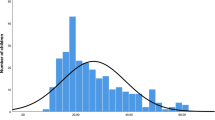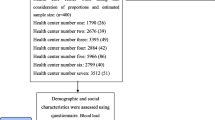Abstract
The purpose of the present study was to make a preliminary evaluation of blood lead levels in school-aged children from three towns of southwestern Sardinia, Portoscuso, S. Antioco and Calasetta, the first of which is very close to a large industrial complex. Blood lead concentration was determined in venous blood samples by graphite furnace atomic absorption spectrophotometry. The survey revealed that children residing in the town of Portoscuso had higher mean blood lead levels (12.7 μg/dl) than children of the same age residing in S. Antioco and Calasetta (8.3 and 8.4 μg/ dl respectively) and that levels were slightly higher in males than in females. This difference is suggested to be a result of the greater fallout of industrial pollutants in the area of Portoscuso.
Similar content being viewed by others
References
AbbrittiG., BriziarelliL., CicioniC., SiracusaA., MorucciP., BellucciE. and GrecoM. (1979): Aumentato assorbimento di piombo in bambini residenti in una zona con elevata produzione ceramica. - Med. Lav. 70: 323–333.
AbbrittiG., SiracusaA., BriziarelliL. and CicioniC. (1982): Inquinamento ambientale da piombo e bambini. - Difesa Sociale 61: 83–95.
Abbritti G., Cicioni C., Blasi F., Franconi U., Bauleo F.A., Fiordi T., Accattoli M.P., Morucci P., Gambelunghe M. and Bellucci E. (1987): Piombo nel-l'ambiente e valori di piombemia nei bambini di tre comuni dell'Umbria uno dei quali ricco di fabbriche di ceramica. Proceedings of Eco-Fiuggi 87 “Inquinamento in ambiente di vita e di lavoro: esperienze e linee di intervento”. - Fiuggi Terme 1: 29–40.
AlessioL. and SartorelliE. (1981): Trattato di Medicina del Lavoro. Piccin Ed. Padova.
BrunekreefB. (1984): The relationship between air lead and blood lead in children: a critical review. -Sci. Tot. Environ. Health 38: 79–120.
Cerquiglini Monteriolo S., Viviani G., Ziemacki G., Di Grazia B., Marinelli A., Bonanni D. and Gubbiotti P. (1984): Indagine sullo stato di inquinamento atmosferico nella zona di Portoscuso (CA). -Rapporti ISTISAN 84/7.
ContuA., FloreC., SchintuM. and SpigaG. (1986): Piombo e cadmio nel suolo e nei vegetali di un'area industrializzata della Sardegna. - Inquinamento 3: 1–6.
E.E.C. Guide-lines of the E.E.C. Council concerning the protection of the population against the risk of lead poisoning (77/312/EED), E.E.C. O.G. 28/04/ 1977.
ElwoodP.C., ClaytonB.E., CoxR.A., DelvesH.T., KingE., MalcomD., RatcliffJ.M. and TaylorJ.F. (1986): Lead in human blood and in the environment near a battery factory. - Br. J. Prev. Soc. Med. 31:154–163.
HawkB.A., SchorederS.R., RobinsonG., OttoD., MushakP., KleinbaumD. and DawsonG. (1986): Relation of lead and social factors to I.Q. of low SES children: a partial replication. - J. Ment. Def. 91:178–183.
JohnsonD.E., TilleryJ.B. and OrevostR.J. (1975): Levels of platinum, palladium and lead in populations of Southern California. - Environ. Health Persp. 12: 27–33.
KayeW.E., NovotnyT.E. and TuckerM. (1987): New ceramics-related industry implicated in elevate blood lead levels in children. - Arch. Environ. Health 42: 161–164.
NeedlemanH.L., GunnoeC., LevitonA., ReedR., PersieH., MaherC. and BarrettP. (1979): Deficits in psycologic and classroom performance of children with elevated dentine lead levels. - N. Engl. J. Med. 300: 689–695.
NeedlemanH.L., BellingerD. and LevitonA. (1981): Does lead at low dose effect intelligence in children?- Pediatrics 68: 894–695.
O'HeaneyJ., KusiakR., DuncanC.E., SmithG.F., SmithL.F. and SpielbergL. (1986): Blood lead and associated risk factors in Ontario children. - Sci. Tot. Environ. 71: 477–483.
RichterE.D., BarasM., BerantM. and TulchinskyT. (1985): Blood zinc protoporphyrin levels in the children and wives of lead battery workers: a preliminary report. - Isr. J. Med. Sci. 21: 761–764.
SchroederS.R., AwhkC., OttoD., MushakP. and HicksE. (1985): Separating the effects of lead and social factors on I.Q. - Environ. Res. 38: 144–154.
SchwartzJ. and OttoD. (1987): Blood lead, hearing thresholds and neurobehavioral development in children and youth. - Arch. Environ. Health 42:153–160.
ThatcherR.W., LesterM.L., McAlasterR. and HorstR. (1982): Effects of low levels of cadmium and lead on cognitive function in children. - Arch. Environ. Health 37: 159–166.
WagnerY., WagnerovaM., WokvnovaD., MadloZ. and MohylaO. (1981): Correlation between blood lead concentrations and some blood protein levels in children residing in lead polluted and control areas. -J. Hyg. Epidemiol. Microbiol. Immunol. 25: 97–112.
Author information
Authors and Affiliations
Additional information
Corresponding author.
Rights and permissions
About this article
Cite this article
Cardia, P., Pau, M., Ibba, A. et al. Blood lead levels in children of S.W. Sardinia. Eur J Epidemiol 5, 378–381 (1989). https://doi.org/10.1007/BF00144841
Issue Date:
DOI: https://doi.org/10.1007/BF00144841




